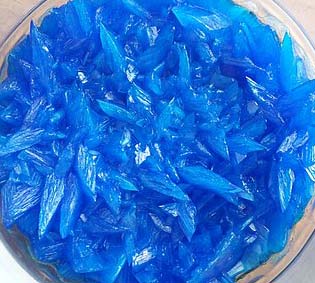1. Rain water is weakly acidic because it contains dissolved carbon dioxide. Which of these is a possible pH for rain water? |
|
| 2. Litmus, phenolphthalein and methyl orange are all indicators which can be used to distinguish between acids and alkalis.
What are the correct colours of these indicators in alkali?
| |
litmus |
phenolphthalein |
Methyl orange |
| A |
blue |
colourless |
yellow |
| B |
blue |
pink |
yellow |
| C |
blue |
pink |
red |
| D |
red |
colourless |
red |
|
|
3. Which of the following statements about pH is correct?
- A. The lower the concentration of hydroxide ions in a solution the higher the pH
- B. The pH decreases when calcium oxide is added to dilute hydrochloric acid
- C. The higher the concentration of hydrogen ions in a solution the lower the pH
- D. Acidic solutions have a pH value above 7
|
|
4. Sulfuric acid is a strong acid. A strong acid is one which..
- A. is fully dissociated into ions in aqueous solution
- B. is partially dissociated into ions in aqueous solution
- C. contains a large amount of acid dissolved in water
- D. contains a small amount of acid dissolved in water
|
|
5. Which is NOT a typical characteristic of acids?
- A. They react with metal oxides producing hydrogen
- B. They react with carbonates producing carbon dioxide
- C. They react with alkalis producing water
- D. They turn blue litmus paper red
|
|
6. Acids form salts. Select the row that correctly states the type of salt formed from each acid.
| |
Hydrochloric acid |
Sulfuric acid |
Nitric acid |
| A |
chlorate |
sulfide |
nitride |
| B |
chlorate |
sulfate |
nitrate |
| C |
chloride |
sulfate |
nitride |
| D |
chloride |
sulfate |
nitrate |
|
|
Q7-9:
A student prepared a sample of hydrated copper(II)sulfate crystals by reacting excess copper(II)carbonate with dilute sulfuric acid. |

Crystal Titan | CC 4.0
|
7. The equation for this reaction with the correct state symbols is ..
- A. CuCO3(s) + H2SO4(l) → CuSO4(l) + H2O(l) + CO2(g)
- B. CuCO3(s) + H2SO4(aq) → CuSO4(aq) + H2O(l) + CO2(g)
- C. CuCO3(s) + H2SO4(l) → CuSO4(aq) + H2O(l) + CO2(g)
- D. CuCO3(aq) + H2SO4(aq) → CuSO4(aq) + H2O(l) + CO2(g)
|
|
8. How would the student know when she had added an excess of copper(II)carbonate?
- A. the solution would turn blue in colour
- B. the temperature would rise
- C. effervescence would stop and solid would remain in the mixture
- D. all the solid would disappear
|
|
9. What techniques would the student use to:
(a) separate the excess copper(II)carbonate from the mixture?
(b) obtain hydrated copper(II)sulfate crystals from the solution? |
|
| |
Separate excess copper(II) carbonate |
Obtain hydrated copper(II)sulfate crystals |
| A |
filtration |
crystallisation |
| B |
evaporation |
distillation |
| C |
filtration |
distillation |
| D |
evaporation |
crystallisation |
|
|
10. Which statements are NOT true about bases?
| I. Bases reacts with acids to form salt and water only |
| II. Bases turn damp blue litmus paper to red |
| III. An alkali is an insoluble base |
| |
- A. I and II only
- B. I and III only
- C. II and III only
- D. I, II and III
|
|
|